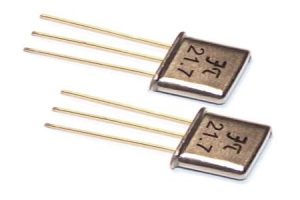What is a SAW filter, and how does it work?
What is meant by the SAW filter?
A Surface Acoustic Wave (SAW) filter is an electrical filter that eliminates particular frequencies from a signal using acoustic waves. When an electrical signal is supplied to the piezoelectric substrate that makes up the filter, acoustic waves are produced. The signal is then affected by these waves to remove undesirable frequencies. Specialized electrical filters called SAW filter is employed in several applications.
How does the SAW filter operate?
A SAW filter produces surface acoustic waves using a piezoelectric substrate, such as quartz. A group of input and output transducers on the substrate’s surface receive an electrical signal, which causes them to create waves. The vibrating transducers produce acoustic waves due to the electrical signal and travel through the substrate.
Step 1:
The electrical signal is impacted by the interaction of the acoustic waves with the substrate as they pass through it. Depending on the filter’s design, certain frequencies are filtered out. This is accomplished through the acoustic resonance phenomenon, in which some acoustic wave frequencies are amplified, and others are suppressed.
Step 2:
Another set of transducers on the substrate’s surface outputs the filtered signal afterwards. The layout and design of the transducers, as well as the substrate, affect the frequency response of the filter. SAW filters may have a high level of selectivity, allowing them to pass through desirable frequencies with little distortion while filtering out undesired frequencies.
Step 3:
These filters are frequently employed in wireless communication systems, including mobile phones and GPS units, because of their compact size, low insertion loss, and good selectivity. Radar systems, television receivers, and medical gadgets are just a few additional uses for them.
What are some applications for SAW filters?
Due to their excellent selectivity, low insertion loss, and small size, these filters are utilized in various applications across several industries. The following are some typical uses for these filters:
- Wireless communication system:
Mobile phones, GPS, satellite communication, and wireless local area networks are just a few examples of devices that employ these filters in wireless communication (WLANs). They are employed to filter out undesirable frequencies to guarantee that intended signals are delivered and received with the least amount of jitter.
- Consumer electronics:
The SAW filter is used in consumer electronics items such as television receivers, satellite radios, and digital radios to enhance signal quality and lessen interference.
- Aerospace and defense:
These filters filter out undesirable signals to ensure that important information is sent and received properly in radar systems, communication systems, and electronic warfare systems.
- Industrial automation:
These filters filter out undesirable signals and guarantee precise measurements are collected in industrial automation applications, such as sensors and process control systems.
- Medical devices:
These filters filter extraneous signals and assure precise readings in medical devices, including ultrasound equipment and patient monitoring systems.

Understanding the benefits of the SAW filter:
These filters are especially helpful in situations where precise signal filtering is necessary, such as in wireless communication systems, electronic instruments, and medical equipment, because of their high selectivity. These systems may filter out undesirable signals and noise while maintaining the quality of the intended signal by utilizing these filters, which enhances the system’s overall performance.
- High rejection bandwidths:
The ability of these filters to offer large rejection bandwidths is one of their advantages. As a result, undesirable frequencies that are near the intended signal’s frequency range can be successfully filtered out using these filters. Using the piezoelectric substrate’s acoustic resonance capabilities, these filters can reduce signals across a wide frequency range while maintaining a high rejection bandwidth. Higher rejection bandwidths can make filters more helpful in situations where interference from neighbouring channels or noise is an issue compared to other types of filters, such as active or LC filters. For instance, filters can be employed in wireless communication systems to block undesired signals from other channels, lowering the likelihood of signal interference and enhancing the overall quality of the connection.
- Low insertion loss:
Low insertion loss is one of the key advantages of employing these filters. As a signal travels through a filter, it experiences insertion loss, a drop in signal strength. As these filters have a low insertion loss, the signal quality does not suffer noticeably due to their use. This is so that the quantity of energy lost during signal transmission is decreased. SAW filters run passively and do not require a power source to work. Low insertion loss is especially crucial in systems such as radar systems, medical equipment, and wireless communication systems where signal quality is crucial. These systems may filter out undesirable signals and noise while maintaining the system’s integrity by utilizing these filters. These systems may remove extraneous signals and noise while maintaining the integrity of the target signal by utilizing these filters. A SAW filter is perfect for battery-powered devices due to its low insertion loss, reducing power consumption.
High selectivity is another important advantage of employing these filters. “Selectivity” describes a filter’s capacity to separate unwanted signals of similar frequency from those it wants to pass through. Using the piezoelectric substrate’s acoustic resonance characteristics, these filters may offer great selectivity. This filter causes surface acoustic waves moving through the substrate to interact with signals passing through it. The waves are produced with a certain resonance frequency that matches the frequency of the intended signal in mind. Due to the attenuation of undesirable signals near in frequency, the SM320C6678ACYPW SAW filter can magnify the desired signal while attenuating any others.
Conclusion:
An electrical filter called a SAW, or surface acoustic wave filter is used to isolate one signal from another. It operates by filtering out some signal frequencies while allowing others to pass through using an acoustic wave generated by a transducer. Two automated production facilities operated by ChipSun Technologies Co., Ltd. were outfitted with the most cutting-edge manufacturing and testing equipment. Qualified engineers and a technical team form a strong technical force. With consistent efforts, our quality and service have gained the respect and trust of the clients.
